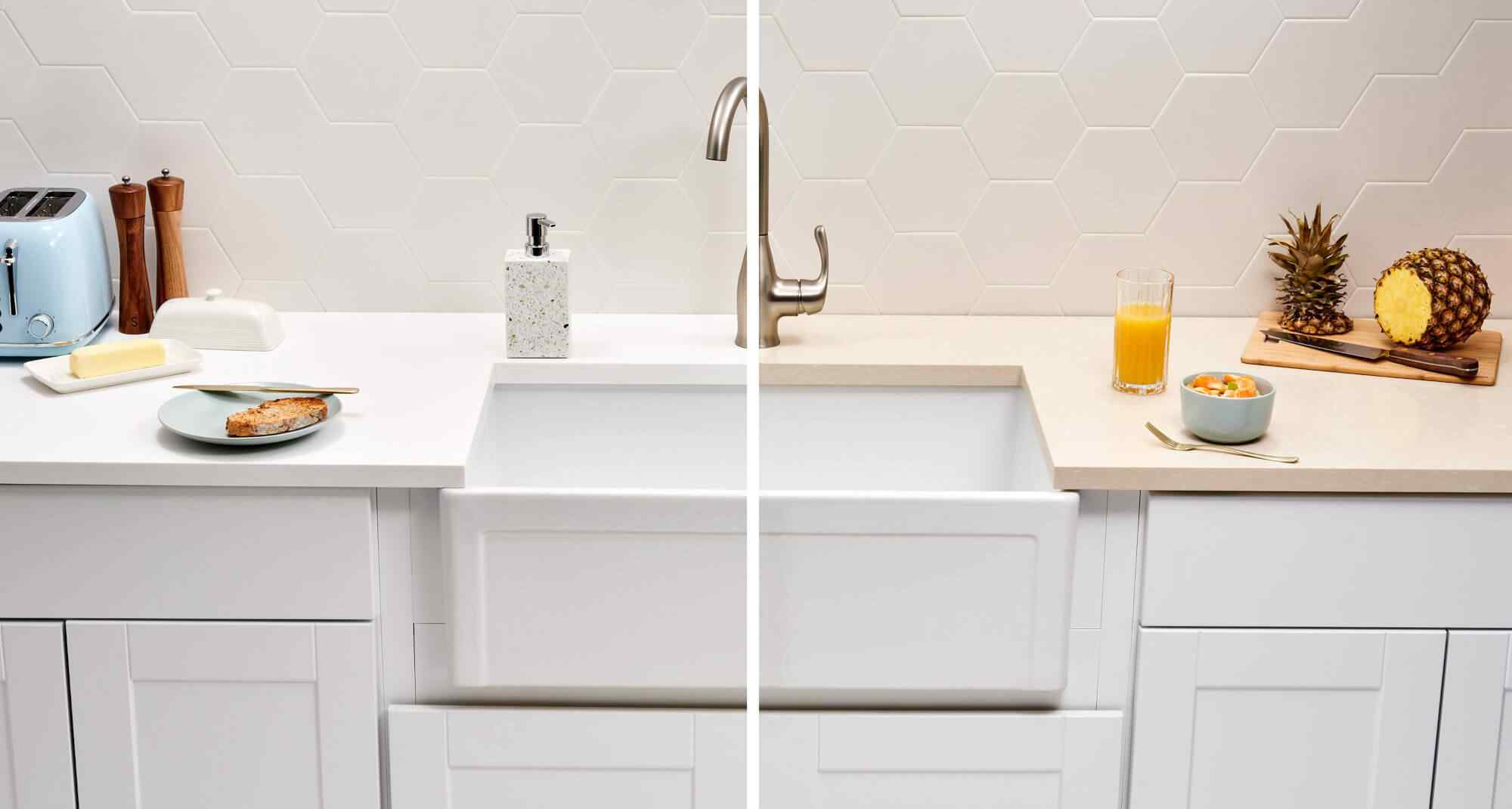Both Corian and Silestone are non-porous, durable, and attractive, but which one is best for your countertops?
Silestone and Corian are two popular countertop materials that have been around for a long time. While Silestone quartz is a natural material, Corian is a solid surface countertops. The material was created by DuPont in 1967 and is a popular option for kitchen countertops over the years. While Corian technically refers to a specific brand, the term has become more widely used to refer to solid surface countertops.

Both Silestone and Corian countertops are durable, attractive, and easy to clean, but they have some notable differences in terms of heat and scratch resistance, cost, and maintenance. Let’s help you decide which is best for your home.
Corian and Silestone countertops are made with natural minerals and binding resins
Silestone and Corian are similar in that they are both solid surface materials made by combining natural minerals with binding agents. They differ from natural slab materials like granite and marble, which are made from 100 percent natural stone.
Here are a few other ways to compare Silestone and Corian.
Corian solid surface counters are made by combining acrylic polymer and alumina trihydrate, a material derived from a type of sedimentary rock called bauxite ore. Corian is typically made up of 33 percent binding resins and 66 percent minerals. The colors in Corian countertops come from pigments added to the resin, so they are consistent all the way through.
Silestone is an engineered stone that ranges from 90 to 94 percent quartz crystals mixed with 6 to 10 percent epoxy resin. Pigments are also added to give the countertop its color. The material is available in a wide range of colors and patterns that mimic natural stone surfaces like granite or marble.
Silestone countertops are more scratch-resistant and heat-resistant than Corian countertops.
The biggest difference between these materials is in their resistance to heat. While Silestone is not completely heat-resistant, it does perform better than Corian—hot pots and pans won’t damage the surface of Silestone if they are put down for a few seconds.
Unlike Silestone counters, a Corian counters can be damaged by high temperatures. It’s best to use trivets or heat protectors under pots and pans for stone and Corian countertops.
In terms of scratch resistance, Silestone has the edge. It’s a harder material, so it’s less prone to scratching than Corian.
Corian solid surface countertops are easier to repair compared to Silestone.
Another way to compare Corian solid surface countertops vs. Silestone quartz is how they’re repaired when damaged. Corian may be more prone to scratching, but the scratches can be buffed away easily. You can sand out surface scratches or fill in chips with a repair kit.
With Silestone counters, repairs are less friendly. You need to apply a special filler compound with a syringe applicator and then polish it down to match the finish of the rest of your countertop.
Both Silestone quartz and Corian countertops are nonporous and highly resistant to stains and germs.
One of the primary similarities between Silestone quartz and Corian is their nonporous finish. The two materials are both ideal for kitchen countertops because they resist stains and are incredibly hygienic.
Since Corian is made with a high ratio of resin, it’s known for being completely nonporous, making it resistant to stains. It doesn’t require a sealant and resists bacteria since there are no crevices where germs can hide out. Silestone quartz countertops aren’t completely nonporous, but they’re close enough so that they don’t need to be sealed like other stone surfaces.
Corian is more flexible than Silestone quartz when it comes to curves and unique countertop shapes.
While both Silestone quartz and Corian are made with binding resins, Corian countertops use a higher percentage of these synthetic materials. This allows for greater flexibility in terms of shape, since the resins can be more easily molded into curved and rounded forms. This means that Corian countertops can be crafted into unique shapes and designed to better accommodate sinks and other countertop features.
Both materials can also be constructed as large single slabs, so unsightly seams from kitchen counters can be avoided. Since they can be made without seams, both Corian and Silestone quartz countertops are also more hygienic.
The costs for Corian vs. Silestone quartz countertops are comparable.
When it comes to Corian versus Silestone quartz, shoppers will find Silestone counters to be slightly more expensive than Corian in most cases. Expect to pay $50 to $100 per square foot installed for either Silestone quartz or Corian countertops.
Corian countertops cost between $45 to $65 per square foot before installation costs are factored in. Installing Corian counters typically costs $75 an hour. The cost of Corian countertops depends on the popularity of the color in question, with more popular colors carrying higher price points.
The price of Silestone ranges from $50 to $200 per square foot installed, and the average price of installing Silestone kitchen countertops ranges from $3,000 to $7,500. Corian costs between $2,200 to $5,000. This means both materials are more expensive than laminate countertops, but they are also more durable and heat resistant than laminate.